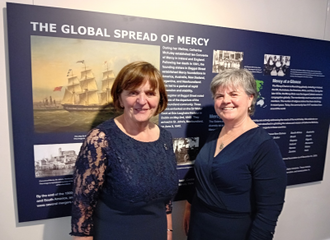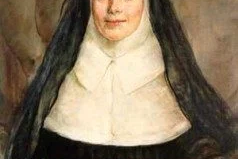Dublin: Exhibition on Catherine McAuley, Founder of the Sisters of Mercy

Sisters Patricia O'Donovan and Margaret Daly at the exhibition launch.
One of the most famous Irish women was Catherine McAuley who was born in 1778 in Dublin. In 1824, she used her inheritance from an Irish couple (the Callaghans) whom she had served for twenty years to build a large House of Mercy where she and other lay women would shelter homeless women, reach out to the sick and dying and educate poor girls.
The founders would be very disappointed if they were alive today to witness the extent of homelessness in Dublin city and elsewhere despite the prosperity and wealth that prevails.
The House at 64a Lower Baggot Street opened in 1827. To give these efforts greater stability, Catherine and her co-workers founded a new religious congregation when on 12 December 1831, she and two others professed their vows as the first Sisters of Mercy.
Before her death on 11 November 1841, Catherine founded convents and works of mercy throughout Ireland and England and in following years the congregation spread worldwide.
In the 1980s, interest in the future of the Baggot Street house was aroused among Sisters of Mercy worldwide and in the possibility of an international collaboration in the restoration of the historic place. The consensus was that the original house founded by Catherine should be held as a heritage house and Mercy home for the Sisters of Mercy worldwide. In order to hold it as such, Mercy International Association was formed. This was an association of the leaders of the Mercy families around the world.
The house was restored in 1994 and is now the Mercy International Centre and home to the Mercy Family from all over the globe. People from many countries come to visit Catherine's original foundation. The house is a centre of hospitality to all who come. It is a place of pilgrimage and renewal for those who want to spend time and touch into the spirit of Catherine. Her chapel, room and grave are special places of pilgrimage. It is a Heritage Centre and holds many precious memorabilia belonging to Catherine.
As well as representing the origins of the Sisters of Mercy and its links with the past, the Centre calls and challenges the Mercy family of today to hear the cries of the poor that have assumed global proportions and to use their resources to respond to issues of global poverty and thus "to keep alive the founding spirit of Catherine among peoples of the world most in need of God's compassion and mercy" (MIA Vision Statement).
This month, the official launch of the "Catherine McAuley and the Mission of Mercy" heritage exhibition took place at the Centre. It is one-of-a-kind exhibition that delves into the material history of the house, the social context in which Catherine McAuley and her early companions lived, and the daily routines and religious practices of the founding Sisters of Mercy.
Moreover, several unique artefacts from Catherine McAuley's life and mission are on display. Those attending the launch were treated to a series of heritage presentations and talks by Sisters Patricia O'Donovan, Margaret Daly, and Sheila Carney, along with input from Carla Soden and Susan Cahill.
Commenting on the exhibition, Sr Patricia O'Donovan, CEO of Mercy International Association, said: "The launch of the heritage exhibition is a lifegiving moment for MIA. Our desire is that the story of Catherine McAuley and the founding sisters will continue to be a source of inspiration, guidance, and wisdom for the call of Mercy today and tomorrow in our world. I wish to take this opportunity to thank Irish designers, Darac Museum Storage & Display and Just Print, who worked closely with our exhibition team on the display."
Speaking at the launch, Sr Margaret Daly, Head of Heritage and Spirituality for Mercy International Association, said: "Catherine McAuley's vision and achievements reach across the centuries. Her commitment to social justice, her courage, and her immense support for women and children are remarkable. I believe her story will strike a chord with people worldwide today."
This innovative heritage project involved a close collaboration between exhibition curator Susan Cahill and the Congregation of the Sisters of Mercy Archive, particularly Marianne Cosgrove, the Congregational Archivist.
The unique exhibition presents a social history of Dublin at that time and the role of the Sisters of Mercy in shaping the future. It offers visitors a fascinating library of heritage audio recordings, an interactive digital archive, and a unique collection of stories, photos, and artefacts from the first House of Mercy. The exhibition is open to the public, and all are very welcome.
For further information see: www.mercyworld.org/our-centre/.
(Matt Moran is a writer and author living in Cork. He is a former Chairman of the Board of Misean Cara that supports the development work of Irish missionaries in the Global South. He is author of the "Legacy of Irish Missionaries Lives On" available from www.buythebook.ie).


















